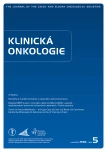Solid Pseudopapillary Tumor of the Pancreas – Rare Neoplastic Disease in 20-Year-Old Woman
Authors:
Fichtl Jakub 1; Skalický Tomáš 1; Vodička Josef 1; Třeška Vladislav 1; Tupý Radek 2; Hes Ondřej 3
Authors place of work:
Chirurgická klinika LF UK a FN Plzeň
1; Klinika zobrazovacích metod LF UK a FN Plzeň 3 Šiklův ústav patologie, LF UK a FN Plzeň
2
Published in the journal:
Klin Onkol 2018; 31(5): 376-379
Category:
Kazuistika
doi:
https://doi.org/10.14735/amko2018376
Summary
Introduction:
Benign cystic tumors represent only 2% of all pancreatic tumors (pancreatic cancer – PC). In contrast to malignant cystic tumors, these tumors occur typically in young women. A solid pseudopapillary tumor is a relatively rare affliction representing less than 4% of cystic PC. Although the tumor is considered benign, metastasis, especially to the spleen, has been reported in approximately 0.5–4% patients. Despite R0 resection, vascular and perineural invasion is monitored in 20% of cases. Invasion is the cause of tumor relapse in up to one third of affected patients. Characteristic features of the disease are latent clinical indicators such as signs of pain and malfunction of intestinal passage. The diagnostics is based on MR, sometimes in combination with positron emission tomography. Medical treatment is specifically surgical.
Case history:
Authors present a case of a 20-year-old female patient who was examined due to pain in the epigastrium, further exasperated by a voluminous expansion of the abdominal cavity. An initial ultra-sonographic examination was conducted to examine for possible nodular focal nodular hyperplasia of the liver; however, an MRI scan revealed the likelihood of a malignant tumor in the subhepatic region. During laparotomy, a tumor protruding from the head of the pancreas was discovered and removed. Histological examination showed it was a solid pseudopapillary pancreatic tumor. After a month of good post-operative progress, the patient was re-operated because of the presence of pancreatic fistula. Complete healing of the fistula was achieved after total parenteral nutrition and administration of sandostatin. At her last examination, the patient was without any problems.
Conclusion:
Solid pseudopapillary pancreatic tumors are rare, mainly benign lesions. It is essential to consider them in the differential diagnostics of afflictions of the subhepatic region, especially in young women. The only generally accepted cure nowadays is surgical resection. It is necessary to monitor patients consistently considering the rather high frequency of relapse of disease despite R0 resections. In the case of surgical removal, the 5-year survival rate is near 97%.
Key words:
solid pseudopapillary tumor of pancreas – diagnostics – therapy
The authors declare they have no potential conflicts of interest concerning drugs, products, or services used in the study.
The Editorial Board declares that the manuscript met the ICMJE recommendation for biomedical papers.
Submitted: 17. 4. 2018
Accepted: 13. 8. 2018
Zdroje
1. de Castro SM, Singhal D, Aronson DC et al. Management of solid-pseudopapillary neoplasms of the pancreas: a comparison with standard pancreatic neoplasms. World J Surg 2007; 31 (5): 1130–1135. doi: 10.1007/s00268-006-0214-2.
2. Farrell JJ. Prevalence, diagnosis and management of pancreatic cystic neoplasms: current status and future directions. Gut Liver 2015; 9 (5): 571–589. doi: 10.5009/gnl15063.
3. Papavramidis T, Papavramidis S. Solid pseudopapillary tumors of the pancreas: review of 718 patients reported in English literature. J Am Coll Surg 2005; 200 (6): 965–972. doi: 10.1016/j.jamcollsurg.2005.02.011.
4. Reddy S, Cameron JL, Scudiere J et al. Surgical management of solid-pseudopapillary neoplasms of the pancreas (Franz or Hamoudi tumors): a large single-institutional series. J Am Coll Surg 2009; 208 (5): 950–957. doi: 10.1016/j.jamcollsurg.2009.01.044.
5. Lee SE, Jang JY, Hwang DW et al. Clinical features and outcome of solid pseudopapillary neoplasm: differences between adults and children. Arch Surg 2008; 143 (12): 1218–1221. doi: 10.1001/archsurg.143.12.1218.
6. Hamoudi AB, Misugi K, Grosfeld JL et al. Papillary epithelial neoplasm of pancreas in a child. Report of a case with electron microscopy. Cancer 1970; 26 (5): 1126–1134.
7. Pettinato G, Di Vizio D, Manivel JC et al. Solid-pseudopapillary tumor of the pancreas: a neoplasm with distinct and highly characteristic cytological features. Diagn Cytopathol 2002; 27 (6): 325–334. doi: 10.1002/dc.10 189.
8. Brázdil J, Hermanová M, Křen L et al. Solidní pseudopapilární tumor pankreatu: soubor pěti případů. Rozhl Chir 2004; 83 (2): 73–78.
9. Wang Y, Miller FH, Chen ZE et al. Diffusion-weighted MR imaging of solid and cystic lesions of the pancreas. Radiographics 2011; 31 (3): E47–E64. doi: 10.1148/rg.313105174.
10. Zhang RC, Yan JF, Xu XW et al. Laparoscopic vs open distal pancreatectomy for solid pseudopapillary tumor of the pancreas. World J Gastroenterol 2013; 19 (37): 6272–6277. doi: 10.3748/wjg.v19.i37.6272.
11. Kanter J, Wilson DB, Strasberg S. Downsizing to resectability of a large solid and cystic papillary tumor of the pancreas by single-agent chemotherapy. J Pediatr Surg 2009; 44 (10): e23–e25. doi: 10.1016/j.jpedsurg.2009.07.026.
Štítky
Detská onkológia Chirurgia všeobecná OnkológiaČlánok vyšiel v časopise
Klinická onkologie

2018 Číslo 5
- Metamizol jako analgetikum první volby: kdy, pro koho, jak a proč?
- Nejasný stín na plicích – kazuistika
- Fixní kombinace paracetamol/kodein nabízí synergické analgetické účinky
- Tramadol a paracetamol v tlumení poextrakční bolesti
- Realita liečby bolesti v paliatívnej starostlivosti v Nemecku
Najčítanejšie v tomto čísle
- Solidní pseudopapilární tumor pankreatu – vzácné onemocnění 20leté ženy
- Psychoneuroimunológia nádorových chorôb – súčasné východiská a perspektívy
- Význam mutace BRAFV600E v tyreoidální onkologii a možnosti léčebného ovlivnění – aktuální poznatky a výsledky studií
- Jubilant doc. MUDr. Bohuslav Konopásek, CSc.
